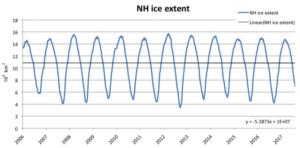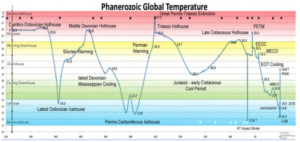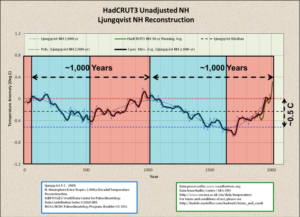by Kenneth Richard, August 14, 2017 in NoTricksZone
Archives mensuelles : août 2017
On Carbon Dioxide Toxicity
by Blair King, April 10, 2016
Specifically the Bureau of Land Management Health Risk Evaluation for Cabon Dioxyde points out:
A value of 40,000 ppm is considered immediately dangerous to life and health based on the fact that a 30-minute exposure to 50,000 ppm produces intoxication, and concentrations greater than that (7-10%) produce unconsciousness (NIOSH 1996; Tox. Review 2005). Additionally, acute toxicity data show the lethal concentration low (LCLo) for CO2 is 90,000 ppm (9%) over 5 minutes (NIOSH 1996).
See also The Lake Nyos Disaster
See also here
An Inconvenient Split?
by Paul Matthews, August 13, 2017 in CimateScepticism
In many ways, the climate debate has hardly changed since I got interested in it about ten years ago. Public opinion wobbles up and down with hardly any real change. The same tired arguments and claims come round again: every climate conference is the last chance to save the planet; the Arctic ice is always about to vanish in one or two years, or ten years; climate scientists continue to be accused of selecting data sets to create hockeysticks and manipulating data; and teams of climate scientists keep producing reports saying almost exactly the same thing as the previous reports, which then get misrepresented and hyped by the media.
Scientists discover 91 volcanoes below Antarctic ice sheet
by Robin McKie, August 12, 2017 The Guardian
The Edinburgh volcano survey, reported in the Geological Society’s special publications series, involved studying the underside of the west Antarctica ice sheet for hidden peaks of basalt rock similar to those produced by the region’s other volcanoes. Their tips actually lie above the ice and have been spotted by polar explorers over the past century.
Des scientifiques découvrent 91 nouveaux volcans sous les glaciers de l’Antarctique
Statistical link between external climate forcings and modes of ocean variability
by Abdul Malik et al., July 31, 2017, Climate Dynamics, Springer
In this study we investigate statistical link between external climate forcings and modes of ocean variability on inter-annual (3-year) to centennial (100-year) timescales using de-trended semi-partial-cross-correlation analysis technique. To investigate this link we employ observations (AD 1854–1999), climate proxies (AD 1600–1999), and coupled Atmosphere-Ocean-Chemistry Climate Model simulations with SOCOL-MPIOM (AD 1600–1999). We find robust statistical evidence that Atlantic multi-decadal oscillation (AMO) has intrinsic positive correlation with solar activity in all datasets employed. The strength of the relationship between AMO and solar activity is modulated by volcanic eruptions and complex interaction among modes of ocean variability.
NOAA’s Climate.gov Says Natural Wetlands, Tropical Agriculture Responsible For Methane Increases, Not Oil And Gas
by Michael Sandoval, July 18, 2017
Agricultural and wetland emissions” from the planet’s tropical areas, not oil and gas activities in the United States, are more than likely responsible for a post-2007 global increase in methane levels, according to the National Oceanic and Atmospheric Administration’s Climate.gov.
Cooling Deep Oceans – and the Earth’s General Background Temperature
by Wim Röst, August 13, in WUWT (Andy May)
Five million years ago, average temperatures were higher than they are now. During the Pliocene, the era just before the period of the Quaternary Ice Ages, ‘glacials’ did not yet exist because temperatures were too high. As cooling of the deep seas continued, temperatures became that low that large surfaces of the Northern Hemisphere became covered with snow. The earth’s albedo grew fast and large ice sheets started to develop
Uncovered: decades-old government report showing climate data was bad, unfit for purpose
Guest Opinion, Tim Ball, August 12, in WUWT
In 1999, the National Academy of Sciences, the research arm of the National Research Council, released a study expressing concern about the accuracy of the data used in the debate over climate change. They said there are,
“Deficiencies in the accuracy, quality and continuity of the records,” that “place serious limitations on the confidence that can be placed in the research results.”
The people who reached these conclusions and their affiliations at the time follows.
Exposing Staggering Ice Sheet Melt Deceptions
by Kenneth Richard, August 7, 2017 in NoTricksZone reposted Paul Homewood
In recent months, two new papers published in The Cryosphere have provided a condensed summary of the ice-melt and sea-level-rise consequences of global warming for the Arctic region.
1. Between 1900 and 2010, the Greenland Ice Sheet (GIS) has melted so extensively and so rapidly that the GIS ice-melt contribution to global sea level rise has amounted to 1.5 centimeters for the entire 110-year period. One-and-a-half centimeters. That’s 0.59 of an inch!
2. It gets worse. Between 1993 and 2010, the contribution to global sea level rise has been a disturbing 0.39 of a centimeter. Almost 4/10ths of a centimeter. That’s 0.15 of an inch!
Weather-related Natural Disasters: Should we be concerned about a reversion to the mean?
by Prof. Roger Pielke Jr, July 31, 2017, University of Colorado Boulder
The world is presently in an era of unusually low weather disasters. This holds for the weather phenomena that have historically caused the most damage: tropical cyclones, floods, tornadoes and drought. Given how weather events have become politicized in debates over climate change, some find this hard to believe. Fortunately, government and IPCC (Intergovernmental Panel on Climate Change) analyses allow such claims to be adjudicated based on science, and not politics. Here I briefly summarize recent relevant data.
Arctic melt season changes and the Arctic regime shift
Drilling set to begin in British shale
by Daniel J. Graeber, July 28, 2017
“With the decline of North Sea gas and our ever increasing reliance on gas imports, including shale gas imported from the United States, developing an indigenous source of natural gas is critical for U.K. energy security, our economy, jobs and the environment,” Cuadrilla CEO Francis Egan said in a statement. “We are proud as a Lancashire company to be at the forefront of that effort.
US Climate Report Edits Out Highly Embarrassing Section
by Paul Homewood, August 10, 2017, in WUWT
I mentioned in my previous post that the latest draft climate report, published in June, had seemingly left out a rather embarrassing table from the Executive Summary, one that had previously been written into the Third Draft, published last December.
As the link to the Third Draft had disappeared from the NYT, I could not show it.
However, Michael Bastasch, writing over at WUWT, did have the link, so we can now compare the relevant sections.
See also here
Draft Climate Report Leaked To NYT
by Paul Homewood, August 9, 2017 i
The report was completed this year and is a special science section of the National Climate Assessment, which is congressionally mandated every four years. The National Academy of Sciences has signed off on the draft report, and the authors are awaiting permission from the Trump administration to release it.
NYT Admits Its Front Page Climate Change Article Was Wrong, see here
‘Pre-determined science’ Morano reacts to NYT’s ‘leaked’ federal climate doom report: ‘Political report masquerading as science’, see here
Underground magma triggered Earth’s worst mass extinction with greenhouse gases
by Howard Lee, geologist, August 9, 2017 in WUWT
Earth’s most severe mass extinction, the “Great Dying,” began 251.94 million years ago at the end of the Permian period, with the loss of more than 90% of marine species. Precise rock dates published in 2014 and 2015 proved that the extinction coincided with the Siberian Traps LIP, an epic outpouring of lava and intrusions of underground magma covering an area of northern Asia the size of Europe.
But those rock dates presented science with a new puzzle: why was the mass extinction event much shorter than the eruptions? And why did the extinction happen some 300,000 years after the lava began to flow?
The Effects of the Bray Climate and Solar Cycle
by Andy May, August 8, 2017 in WUWT
The Bray cycle is about 2450 years from beginning to end and the Bray Lows, which are the coldest portion of the cycle, are the most important events.
The world is currently within the Quaternary Ice Age and nearly as cold as it has ever been. The normal average temperature of the world is around 20°C, some 5°C warmer than today. To keep recent warming in perspective, it is important to understand that even if the worse predictions of the IPCC were to occur, we would only be returning to the average temperature of the last 560 million years
Phanerozoic Global Temperature from Scotese 2015,
link in the post (.pdf)
Not all glaciers in Antarctica have been affected by climate change
by Geological Society of America, August 8, 2017 in ScienceDaily
Earlier studies had documented little change in the western Ross coastline prior to 1995, and the new study both confirmed the earlier work and extended the analysis to the present time.
This work underscores the complexity of Antarctic climate change and glacier response.
See also here
Warm periods in the 20th century are not unprecedented during the last 2,000 years
by Prof. Quansheng Ge, August 8, 2017 in ClimateChangeDispatch
Prof. Quansheng Ge and his group from the Institute of Geographic Sciences and Natural Resources Research, Chinese Academy of Sciences, collected a large number of proxies and reconstructed a 2000-year temperature series in China with a 10-year resolution, enabling them to quantitatively reveal the characteristics of temperature change in China over a common era.
See also here
The World’s Five Deadliest Volcanoes… and Why They’re So Dangerous
by Elsevier SciTech Connect, August 2017
Since 1600, 278,880 people have been killed by volcanic activity, with many of these deaths attributed to secondary hazards associated with the main eruption. Starvation killed 92,000 following the 1815 Tambora eruption in Indonesia, for example, and a volcanic tsunami killed 36,000 following the 1883 Krakatoa eruption.
Research shows that volcanic activity has shown no let up since the turn of the 21st century – it just hasn’t been around population centres. Indeed, there remain a number of volcanoes poised to blow which pose a major threat to life and livelihood.
Lindzen: On the ‘Death of Skepticism’ Concerning Climate Hysteria
by Richard Lindzen, August 7, 2017 in WUWT
Bill Nye looks forward to the death of skeptics in this Huffington Post essay. There is a sound basis for his wish.
Venezuela : malédiction du pétrole ou du socialisme ?
par Samuel Furfari, 8 août 2017
Le Venezuela se trouve à la croisée des chemins. Se dirige-t-il vers le modernisme ou va-t-il poursuivre sa révolution bolivarienne vers le socialisme qui l’a conduit à la débâcle à laquelle nous assistons aujourd’hui ?
Le pays possède tout ce qu’il faut pour connaitre la prospérité et la paix. Ses abondantes ressources d’hydrocarbures auraient pu en faire la Norvège de l’Amérique latine
Global Warming Caused Vikings to Become Terrorists
by David Middleton, August 7, 2017 in WUWT
So… If climate change caused the Vikings to turn their plowshares into swords, abandoning their farms to become terrorists… the climate change would have been of the warming variety. I’m not a farmer, but it seems to me that global warming would have actually enhanced the Vikings’ ability to farm up around the Arctic Circle.
nother BOM scandal: Australian climate data is being destroyed as routine practice
by JoNova, August 7, 2017 in ClimateChangeDispatch
In the mid-1990s thermometers changed right across Australia — new electronic sensors were installed nearly everywhere. Known as automatic weather sensors (AWS) these are quite different to the old “liquid in glass” type.
The electronic ones can pick up very short bursts of heat—so they can measure extremes of temperatures that the old mercury or liquid thermometers would not pick up unless the spike of heat lasted for a few minutes.
It is difficult (impossible) to believe that across the whole temperature range that these two different instruments would always behave in the exact same way.
Volcanic Northern Winters
by Willis Eschenbach, August 5, 2017 in WUWT
…
Finally, we’ve been told for years that volcanic eruptions cause COOLING … although what cooling is visible in the historical record is generally local, small, and short-lasting. But now, they say eruptions cause Northern Hemisphere winter warming? What’s up with that?
“New study challenges prevailing theory about how deep-sea vents are colonized”… And hydrothermal oil!
by David Middleton, August 4, 2017 in WUWT
An article just published in the Proceedings of the Royal Society B describes two remarkably different hydrothermal vent fields discovered in the southern Gulf of California. Despite being relatively close together, these vents host very different animal communities. This finding contradicts a common scientific assumption that neighboring vents will share similar animal communities. Instead, the new paper suggests that local geology and the chemistry of the vent fluids are important factors affecting vent communities
See aslo here



